Catching Walleyes at Night

* This page contains affiliate links. The Great Lakes Fisherman may earn a commission on items purchased through these links. For more on this, please click here.
When the sun sets and darkness envelops the waters, a new realm of fishing opportunities emerges—particularly for walleye, a species known for its nocturnal feeding habits. Here’s how you can master the art of catching walleyes at night.
Rapala lures are renowned for their lifelike swimming action and ability to mimic injured baitfish—traits that are particularly effective in low-light conditions. Walleye, known for their keen sense of smell and sight in murky waters, are naturally drawn to the erratic movements and realistic appearance of Rapalas, making them a preferred choice for night anglers.
Selecting the Right Lure
When targeting walleye at night, consider the following factors when choosing your lure:
Size and Color
Opt for lures that closely resemble the size and color of the walleye’s natural prey in your fishing area. Darker colors like black, purple, or blue are often effective in low-light conditions. But to be honest, the original black and white floating Rapala is all I have ever used.
Lip and Action
Choose lures with a moderate diving depth and a subtle swimming action. Walleye can be attracted to both shallow-running and deeper-diving lures depending on the water depth and structure.
Noise and Vibration
Some lures are designed with rattles or internal weights that create noise and vibrations, which can be particularly enticing to walleye during the night when visibility is limited.
Techniques for Night Fishing
Casting and Retrieval
Cast your lure near underwater structures such as rocky points, weed beds, or drop-offs where walleye are likely to congregate. Retrieve the lure with a steady, slow pace interrupted by occasional pauses or jerks to mimic a wounded baitfish.
Trolling
If fishing from a boat, consider trolling at a slow to moderate speed. Adjust the depth of your lure by varying the length of line or using sinkers to target walleye at different water levels. For a bit of added action, hold the trolling rod by hand and give it a forward jerk every few seconds. Again this additional action mimics injured bait will noticeably increase your catch.
Jigging
In deeper waters or when walleye are holding near the bottom, jigging with a Jigging Rap can be effective. Drop the lure vertically and use short, sharp movements to create a fluttering action that mimics a struggling prey fish.
Tips for Night Fishing
Bugs
Night fishing can be a blast, but the experience can be completely ruined if you are not prepared for insects. A good bug spray with deet can significantly improve your experience, but the best protecting is clothing. And a head net is a game changer.
Monitor Moon and Weather Conditions
Walleye feeding patterns can be influenced by moon phases and weather conditions. Fishing during a new moon or under overcast skies can sometimes improve your chances of success.
Be Patient and Observant
Night fishing requires patience and keen observation. Pay attention to subtle strikes or changes in water movement that indicate walleye activity.
Night fishing for walleye is a rewarding experience that requires preparation, patience, and a good understanding of walleye behavior. By selecting the right lure, mastering effective fishing techniques, and embracing responsible fishing practices, you can enhance your chances of a successful night on the water. So, pack your gear, embrace the darkness, and let Rapala lures guide you to an unforgettable walleye fishing adventure under the stars. Happy fishing!
